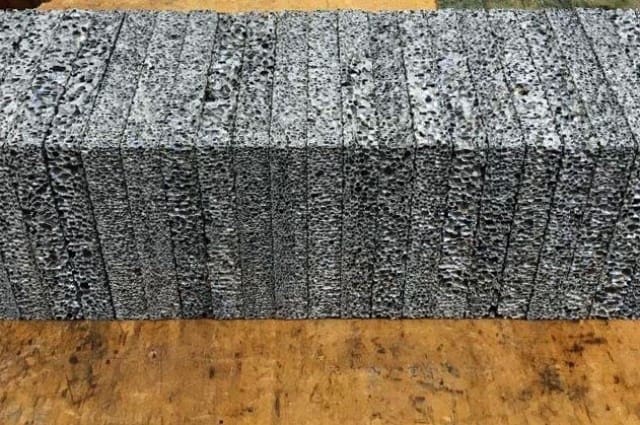
ABERDEEN PROVING GROUND, Md. – Forward Operating Bases are typically surrounded by barbed wire, concrete barriers, gates, watchtowers and other infrastructures. A new material – aluminum foam – may be a possible solution for additional force protection, due to its ability to absorb energy from blasts.
The aluminum foam is added to panels clad with steel that are part of existing structures or bolted together to create larger structures. The panels are also used in jersey style barriers to protect against truck bombs.
Aluminum foam was recently tested in a lab and at an explosives testing range at Picatinny Arsenal, New Jersey, with funding from the Office of the Under Secretary of Defense- Global Capability Programs Foreign Comparative Testing program. The FCT program provides funding to acquire, test and evaluate mature products from foreign industry that may fill a capability gap or satisfy an urgent need. The aluminum foam is manufactured in South Korea and Canada.
“In products where you need a good amount of strength and stiffness that aluminum provides but not all the weight, using the foam opens up a lot of engineering design space without increasing cost,” said Calvin Lim, engineer at Picatinny Arsenal.
Aluminum foam is inexpensive to produce, and it can be made into various sizes and shapes, including panels. While it is currently manufactured and shipped from South Korea and Canada, several companies in the United States are interested in expanding production to make aluminum foam. Creating an affordable supply chain in the U.S. will eliminate difficulties with shipping the product outside the country and create additional jobs in the U.S.
Testing to verify and confirm the manufacturers’ claims was conducted at Picatinny Arsenal. Explosives were initiated next to the aluminum foam panels, which were held in place with I-beams.

“These tests showed how the aluminum foam prevents energy from being transmitted to the other side. To fully replicate previous test data, a higher amount of explosives is needed,’’ Lim said.
Testing was initially conducted in South Korea; during testing, the panels absorbed the energy from the blast, collapsing its cellular structure and preventing any damage from transmitting to the other side. The tests at Picatinny Arsenal, as well as upcoming tests, will determine if aluminum foam will be beneficial for the Army overall, as well as other services.
The FCT program provided funding to purchase additional aluminum foam for Insensitive Munitions testing with XM1128 artillery. This was proposed as a low cost, easy to implement packaging solution to reduce the sensitivity and collateral damage in sympathetic reaction and fragment impact scenarios. This testing has been slated but delayed due to the coronavirus pandemic.

In addition to military uses, aluminum foam is used in a variety of applications including sound mitigation, highway barriers, and storm debris mitigation because of its unique properties.
Because of its versatility, aluminum foam has sparked interest and possible use for military ground vehicles, aircraft and watercraft due to its low weight, stiffness and buoyancy. Lighter vessels and vehicles will not only move faster and use less fuel, they will require fewer refueling trips and enable Soldiers to maneuver more easily.
The Army is working with several companies on additional energy and resource savings, including an energy conscious solution that melts raw scrap aluminum to create aluminum foam. This will reduce steps in the recycling supply chain, which will lead to cost savings.
Future efforts could include using aluminum foam to rapidly manufacture, ship and erect buildings quickly in key locations. Recent research shows many allied countries and adversarial countries have already been using aluminum foam to protect civilian and defense employees.
By Argie Sarantinos, CCDC Public Affairs


I am curious if covered with a ceramic strike plate how this would function in a body armor capacity. Previous videos have shown metal foam stopping a M2AP 30.06 cal round like nothing. Material science has come a long way and the 2020s look to be very promising in body armor development.
I’ve see foamed aluminum in conjunction with boron carbide and compressed kevlar panels that have shredded and stopped bullets with little to no back face deformation. Cost was the issue at the time, but the plates were relatively thin and absorbed the shock very well.
Do the panels have to be replaced after a hit? Or can more foam just be sprayed onto the damaged area?
Panels need to be replaced after impact. They are made in a specific way. It can’t just be sprayed out. It’s a very controlled manufacturing process.